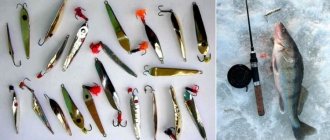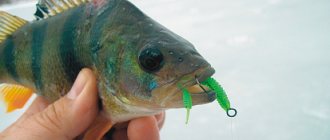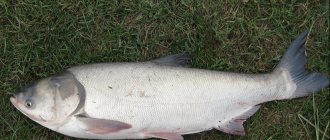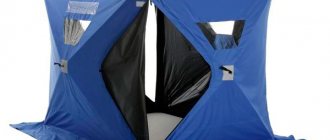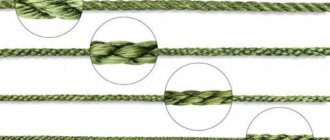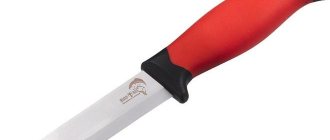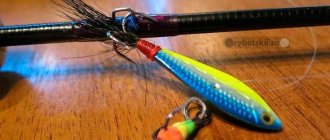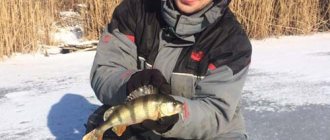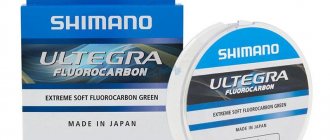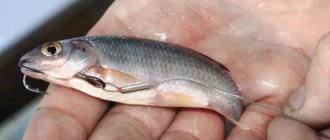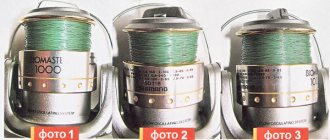Introduction
Winter is a difficult time for all, without exception, inhabitants of fresh water bodies, during which most fish fall into a state reminiscent of suspended animation. Fish is on the border between sleep and sluggish wakefulness, which takes at most a couple of hours a day.
This is due to the fact that the ice crust that covers almost any body of water on the territory of the Russian Federation in the period from November to March-April hides solar heat, prevents water heating, creates blockage and lack of oxygen flow, which in turn leads to the death of many species plant flora. All this begins to rot, thereby poisoning the water.
Perch itself does not show any particular zeal to perform any active actions during the winter cold. Do not forget that the striped fish is an extremely heat-loving fish and, whenever possible, it will always go to where the water temperature is at least a few degrees higher. Thus, from the surface the perch go to a respectful depth.
Older individuals always tend to stick to the bottom. The more mature the fish, the deeper and deeper parts of the reservoir it moves to. The deeper, the better, but in the end it will be much more difficult to get it. On the Onega, Ladoga and neighboring large reservoirs, the humpback fish generally swims calmly at a depth of 80-100 meters, which does not fit in with its image of a lover of tall grass and coastal waters with a maximum depth of three meters.
Large individuals go to the bottom, where they find a secluded place for themselves, like a rotten tree trunk that has fallen to the bottom, in which holes have formed in which they could safely spend the rest of the time before the thaw begins.
Towards the end of winter - the beginning of spring, humpback whales begin to surface and settle in the coastal strip, when the spawning of white fish begins in May, which leads to active hunting among minke whales.
But in winter, on the contrary, perches do not show activity, unless we are talking about small sailor perches trying to stay together. An individual individual does not exceed 20 centimeters in length and weighs no more than 100-200 grams. However, their extreme abundance, coupled with their ubiquity and activity, make sailors one of the most commonly caught fish during winter ice fishing.
So how to catch perch in winter? And what gear is needed for this? Ultimately, what are the requirements for the main component of the entire structure, which is the process of attracting attention and subsequent removal of the river glutton from its natural habitat?
The fishing line for perch in winter must meet certain parameters, without which the catch in the cold season can be catastrophically insignificant. We are talking about both the thickness of the cord itself and its strength. After all, starting from November, in most of the Russian Federation, cold weather begins such that fish, and especially larger individuals of perch, try to leave coastal zones in search of increasingly warmer waters and shelter near the bottom - among stones, snags and the like .
Strength combined with transparency is what a winter perch fishing line should be. You can purchase such a product in fishing stores quite simply - it is marked with a special label on which it is written - “For winter”, i.e. “for winter, for winter.” However, you need to understand how the increased level of strength of the product is achieved. The thing is that such a fishing line, although thin, consists of several links and is called multi-component - knitted, while the usual one - monofilament - is a single cord.
Braided fishing line also has an advantage over mono cord in that it has a significantly lower stretch coefficient, which allows for much better control over the fishing process itself. Also, this type can be considered more resistant to various types of damage and wear.
In order to choose the most suitable option for yourself, you will need to be guided in this choice by the type of gear that will be used for fishing.
Techniques for catching perch using a spinning rod
The technique for catching perch with a spinning rod depends on the fishing method, equipment, and the size of the fish.
To catch large specimens at great depths, a jig is used. The posting method can be:
1. Uniform. Submerged nozzles are carried out in the near-bottom water column. The line is wound with a reel so that the bait moves naturally, without jerking, and sways slightly. This method is suitable for catching active fish.
2. Wavy. The nozzles should vibrate by alternating fast and slow winding of the coil. During its smooth stages, the baits fall down, closer to the bottom. Wave-like wiring is used when hunting a passive predator.
3. Stepped. After casting, the load should lie on the bottom. After a couple of seconds, they begin to sharply reel in the line with two or three turns of the spool. It is necessary that the bait bounces up the steps. Then they pause and wait for it to fall to the bottom again. The step method is used when fishing for sluggish fish.
When catching small perch that gather in shallow water, in the thickets near the shore, the best way is twitching with such wiring techniques.
1. Montonnaya. The tackle is thrown to a promising place, the excess fishing line is reeled in, and the spinning rod is placed near the surface of the water so that the cord lies completely on it. The rod is jerked to the side, causing the bait to move in jerks. Excess fishing line is constantly reeled in using a reel. The vibration amplitude of the bait should be 40 centimeters. It is necessary to make at least two jerks per second. The wiring is suitable for fishing for trophy specimens and when fishing in rivers with strong currents.
2. Rhythmic. After casting the bait, they make a series of rhythmic jerks, then stop for two seconds and resume a series of twitches with the bait. The activity of movements is regulated according to the characteristics of the reservoir and the behavior of the fish.
3. Chaotic. It is similar to rhythmic wiring, but jerks are made with increasing amplitude, and pauses can reach nine seconds. This type of wiring is used when catching large perch using wobblers. It requires fast action spinning rods with soft tips.
If fishing takes place on rivers with fast currents, where the predator is hiding in shelters, you need to use point wiring directly in front of it. In such conditions, the perch will not chase the bait. The depth of the bait is changed to find where the fish are staying. This increases the chances of a good catch.
Line on balancer
In the case of selecting a fishing line for a balancer, one should proceed from the same considerations as in all other cases when it comes to ice fishing, where the water temperature goes far beyond the sub-zero mark. Braided fishing line is the best option for warm water, off-season and summer, but in the cold of winter you will have to dare to use monofilament as it is the most resistant to such temperature conditions.
If the balancer reaches a length of up to three centimeters, then you can get by with a fishing line 0.15 millimeters thick. But if the copy of this tackle you use exceeds all conceivable limits, then it will be impossible to get by with a fishing line that is very noticeable due to its thickness of 0.35 millimeters.
Choosing bait depending on fishing conditions
The characteristics of the reservoir influence the choice of spinners:
• In the dead of winter, when the predator stays at a considerable depth, it is important to use spoons to fish the bottom layers. Their difference is their large mass (up to 20 g), which allows them to quickly reach the bottom. Pershings and gaskets that can be easily weighted with lead solders are suitable.
• At the beginning and end of winter, a variety of cloves, weighing from 1 to 3 grams, are suitable for fishing in shallow water.
• Winter trolling of perch in reservoirs without current occurs with the help of parachutes, diamonds, gliders and other well-gliding lures. They make it possible to increase the fishing area, going far to the sides from the main axis.
• Fishing on the current takes place using elongated baits. To prevent the spinner from being blown to the side, its mass must be large and depends on the strength of the current. You can fish by wire using light baits that are carried away by the flow of water.
Fishing line for a spinner
For catching bass during ice fishing, a monofilament that is more resistant to cold water is often used with a spoon. But here it is worth considering the weight of the spinner itself, which often reaches far from low values. In this case, if the tackle itself is quite heavy, for trolling in water with a very low temperature, it is advisable to use monofilament up to 0.25 millimeters thick, while in warmer times, preference should be given to braided fishing line as it is more durable and informative.
Common perch.
Perch , the most striking representative of the central and northern regions of Europe, Asia and North America, is surpassed in brightness of color only by brook trout and grayling. There are two types of perch that are very similar in appearance and differ only in the color of the body and fins, common and American yellow.
- Common perch.
- Winter fishing rods for trolling.
- Winter lures for perch, how to catch with a lure.
- Catching lures for perch
- Catching perch in winter with a spoon.
- Winter lures for perch 10 best lures for perch.
- Catchy winter lures for perch from Russian manufacturers.
The fish is not very large; the largest specimen caught by fishermen weighed almost 6 kilograms, with a length of over 50 centimeters. Usually you can catch small minke whales, from 150 to 300 grams, the size of a palm, hunting not far from the shore. Humpback whales under 1 kilogram and more are rare in catches.
Although the common river perch is very similar in appearance to the American yellow perch, at the genetic level they are not related.
Winter spinners for perch differ from spinners for winter fishing for other types of fish only in size. Most often these are not large 3-7 centimeter, narrow-bodied baits, made of copper, brass, stainless steel plates with or without galvanic coating.
To increase the weight and solder the hook, lead is soldered onto one of the surfaces of the spoon. There can be from one to three hooks. On some models, instead of a soldered hook, a tee or chain with a hook is hooked through the winding ring.
Vibration in the water column is created by shape and bending. Sometimes, for winter fishing, summer oscillating spoons of small sizes with a driven body are replaced.
Fishing line by transparency
The most durable, due to its smaller diameter, is braided. But it also has its drawbacks, which were mentioned in the text above. In severe frost, it begins to tan, hardens, and does not obey, which has the most negative effect on the operation of the reel system.
Monofilament is devoid of these disadvantages, just like the advantages of a multi-component cord. In any case, modern manufacturers are interested in creating a new, special, super-strong type of monofilament, experimental samples of which are already on the market, although their price exceeds all imaginable and inconceivable limits. In the near future, using ultra-fine and incredibly strong thread will be commonplace.
This type of ultra-thin modern fishing line can also be classified as fluorocarbon. Often, it is classified as a monofilament, but this is not entirely true, because it is created from a completely different, much more durable material, while maintaining approximately the same small thickness of the cord as that of monofilament.
Manufacturers of fishing lines
There are a number of manufacturers whose products can be considered within the framework of this rather specific topic. Below we will present a kind of rating - the top of the best - which will present the names of companies involved in the production of durable and high-quality fishing lines, intended mainly for winter ice fishing, including the ubiquitous perch, which, by the way, is not so dangerous for not the most durable monofilament , like the same pike, he will hardly be able to bite it.
Even if a large humpback whale bites, the structure of its jaw and the arrangement of its teeth eliminate the possibility of losing the tackle due to the fault of the striped robber.
- Sufix Ice Magic
- Sufix Invisiline Fluorocarbon
- Trabucco T-Force XPS Power Plus
- Power Pro Ice-Tec
- Konger Steelon Ice
- Momoi Pro Max Prestige
- Dragon Millennium Winter
- Balsax Ice King
- Shimano Ice Silk shock
- Silver Thread Trout Line
It should be remembered that there is always the possibility of purchasing a counterfeit, so we strongly advise you to purchase these products exclusively in specialized stores and on online platforms that have a positive reputation.
